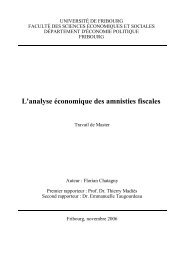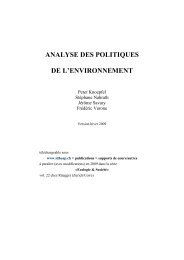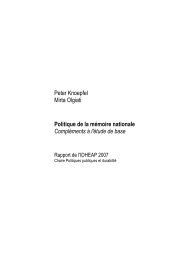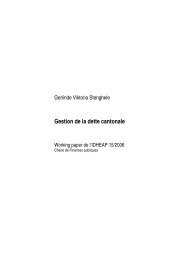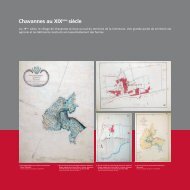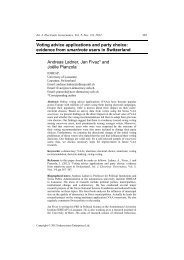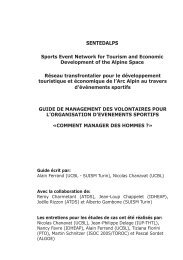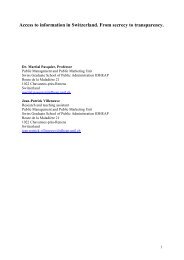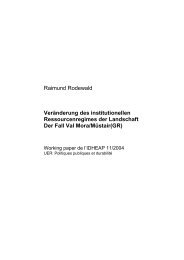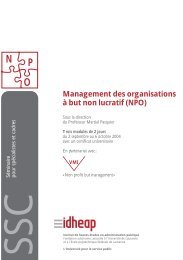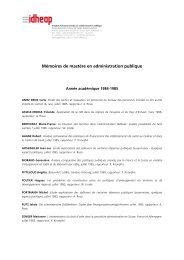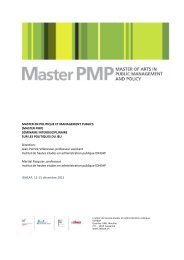Historical Analysis of Institutional Regimes in Switzerland ... - IDHEAP
Historical Analysis of Institutional Regimes in Switzerland ... - IDHEAP
Historical Analysis of Institutional Regimes in Switzerland ... - IDHEAP
Create successful ePaper yourself
Turn your PDF publications into a flip-book with our unique Google optimized e-Paper software.
19<br />
The ma<strong>in</strong> impact <strong>of</strong> this evolution has been a redistribution <strong>of</strong> the relationships between the various<br />
goods and services produced by the resource water (e.g. water policy at the beg<strong>in</strong>n<strong>in</strong>g <strong>of</strong> the century<br />
did not recognise the service <strong>of</strong> water as a liv<strong>in</strong>g environment for plants and animals; the preservation<br />
<strong>of</strong> this service is one <strong>of</strong> the ma<strong>in</strong> objectives <strong>of</strong> the current Federal Law for Water Protection adopted<br />
<strong>in</strong> 1991). Given the knowledge currently available, the problem <strong>of</strong> the impact <strong>of</strong> such regime changes<br />
on susta<strong>in</strong>ability is an open question. There is no <strong>in</strong>tegrated water policy (i.e. one that <strong>in</strong>tegrates all<br />
the goods and services produced by water) <strong>in</strong> <strong>Switzerland</strong>.<br />
IR type: We def<strong>in</strong>e the IR for the resource water as complex because not all aspects <strong>of</strong> the property<br />
and use rights and the policy design are co-ord<strong>in</strong>ated. Although <strong>Switzerland</strong> is <strong>of</strong>ten called the "water<br />
castle" <strong>of</strong> Europe, <strong>in</strong> the area <strong>of</strong> water management, clear shortages still result from the compet<strong>in</strong>g<br />
demands <strong>of</strong> different user groups. The overuse <strong>of</strong> flow<strong>in</strong>g water for the production <strong>of</strong> electricity and<br />
agricultural irrigation have led to damage to biotopes at local and regional level and a reduction <strong>in</strong> fish<br />
stocks. To counteract this, a special water use policy was <strong>in</strong>troduced <strong>in</strong> 1991 (residual quantities<br />
imposed on hydroelectric power plants). The opposition to this measure that was expressed <strong>in</strong> the<br />
mounta<strong>in</strong> cantons (particularly Grisons) shows that this system <strong>in</strong>volved the <strong>in</strong>troduction <strong>of</strong> significant<br />
changes to the basic regulations <strong>in</strong> the area <strong>of</strong> water use. In the case <strong>of</strong> rural protection <strong>of</strong> waters, the<br />
relevant policy design rema<strong>in</strong>s <strong>in</strong>complete (due to lack <strong>of</strong> co-ord<strong>in</strong>ation with agricultural policy) and<br />
lack<strong>in</strong>g <strong>in</strong> coherence (weak design). In the case <strong>of</strong> the use <strong>of</strong> water for energy purposes (residual<br />
water regulations), policy designs should show greater <strong>in</strong>ternal coherence (strong or at least partial<br />
design). F<strong>in</strong>ally, it should also be mentioned that the polluter-pays-pr<strong>in</strong>ciple was not <strong>in</strong>troduced at<br />
decree level until 1999.<br />
d) Soil (complex IR)<br />
Goods and services: As a prelim<strong>in</strong>ary comment, it is important to reiterate that all natural resources<br />
are (<strong>in</strong>)directly associated with soil (soil as a filter <strong>in</strong> the water cycle, as site for forests, as a “carrier”<br />
<strong>of</strong> landscape components, as absorption s<strong>in</strong>k for air pollutants etc.). The goods and services<br />
provided by the resource soil <strong>in</strong>clude construction land (for <strong>in</strong>dustry, commerce, settlement and<br />
public <strong>in</strong>frastructure), natural habitats for biodiverse plants and animals (moors, national park, hunt<strong>in</strong>g<br />
etc.), sites for waste deposits (all k<strong>in</strong>ds <strong>of</strong> waste, <strong>in</strong>clud<strong>in</strong>g nuclear), production <strong>of</strong> raw material<br />
(gravel, m<strong>in</strong>erals etc.) production <strong>of</strong> biomass (agricultural area, forest, meadows etc.) and filter (for<br />
substances <strong>in</strong> air and water).<br />
Property rights: Soil is the central resource for Swiss property law (right <strong>of</strong> disposal and use <strong>in</strong><br />
accordance with Article 641 Paragraph 1 and object <strong>of</strong> property <strong>in</strong> accordance with Article 655 <strong>of</strong><br />
the Swiss Civil Code). The “pr<strong>in</strong>ciple <strong>of</strong> accession” (Article 667 Swiss Civil Code) states that all<br />
objects which are connected to the soil <strong>in</strong> such a way that their spatial situation cannot be changed<br />
without substance, shall share the legal fate <strong>of</strong> the site <strong>in</strong> question. Ownership <strong>of</strong> the soil was also<br />
formally secured <strong>in</strong> constitutional terms <strong>in</strong> 1969 (Article 22ter aBV, Art. 26 nBV. Hence <strong>in</strong><br />
<strong>Switzerland</strong>, there is de facto not a s<strong>in</strong>gle square <strong>in</strong>ch <strong>of</strong> land that is not governed property and use<br />
rights which have not been def<strong>in</strong>ed (<strong>in</strong> terms <strong>of</strong> content) by different public law regulations<br />
(particularly regional development). Nowadays, however, there are no <strong>of</strong>ficial statistics on the<br />
division <strong>of</strong> the soil <strong>in</strong> terms <strong>of</strong> state and private property and <strong>in</strong> terms <strong>of</strong> construction, agricultural and<br />
protected zones. Partial data is, however, available with respect to the effective use <strong>of</strong> soil <strong>in</strong> 1995:<br />
approximately 38% <strong>of</strong> Swiss soil is used for agricultural purposes, 30% is used by forests, 25% is<br />
unproductive and 6% is accounted for by settlement and <strong>in</strong>frastructure (Duvanel/Goujon 1995). It



